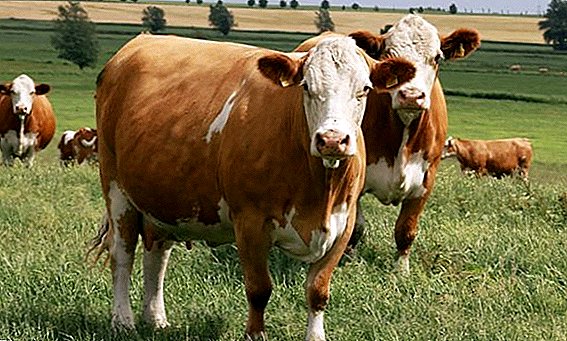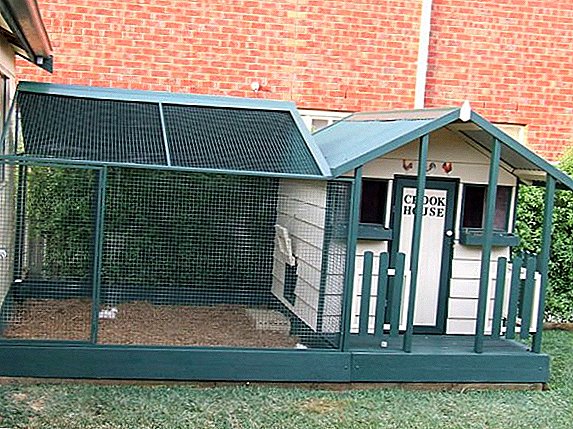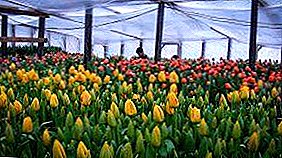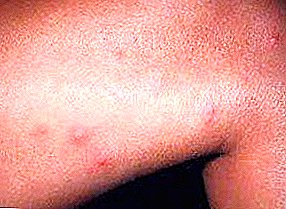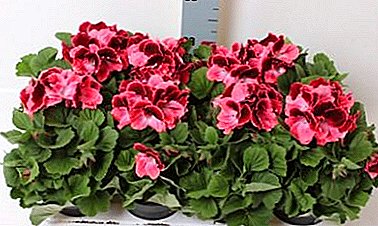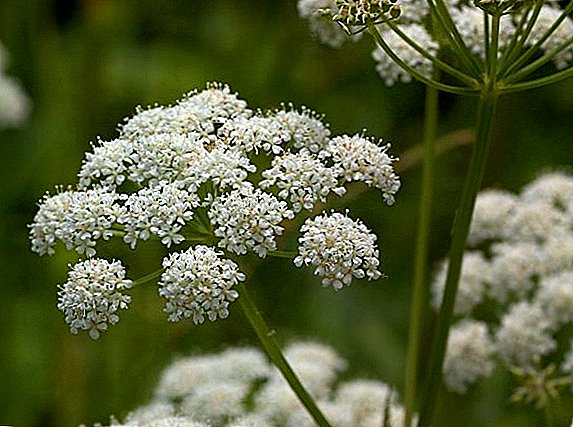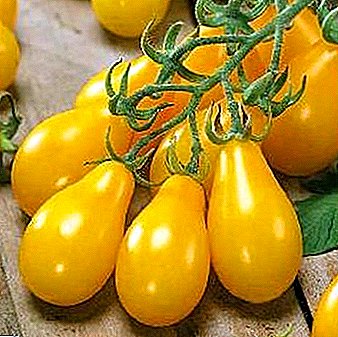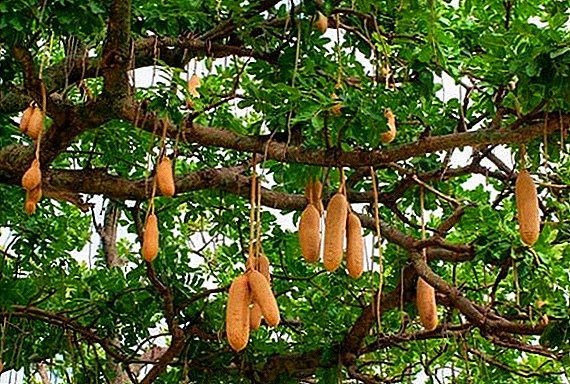 The world of plant nature harbors amazing and very unusual representatives of the flora: the tree of life, dragon, rainbow, cannon, bottle, mangrove and many other types of trees amaze with their beauty and exoticism. In this article we will talk about the sausage tree - where it grows, what are its healing properties, and whether it is possible to grow such a wonder at home.
The world of plant nature harbors amazing and very unusual representatives of the flora: the tree of life, dragon, rainbow, cannon, bottle, mangrove and many other types of trees amaze with their beauty and exoticism. In this article we will talk about the sausage tree - where it grows, what are its healing properties, and whether it is possible to grow such a wonder at home.
Description
Unfortunately, such a tasty name of this plant does not mean that its fruits are edible - Cygelia is called a sausage tree only because of the similarity of the appearance of its fruit with the meat product of the same name. When European travelers in the XIX century first saw this plant on the African continent, they immediately dubbed it sausage, this name is still used.

Only later did the Europeans find out that the fruits of raw kegel are not only inedible, but even poisonous. - it immediately cooled their interest in this plant. And in vain: African residents still make traditional local drink from the fruits of kigel, they use dried seeds of plants for food, and animals such as hippos and giraffes enjoy the raw fruits with pleasure.
Cygelia tree can reach a height of 15 meters - it is sprawling and with a thick crown. When grown in greenhouses and other indoor areas, rarely exceeds the height of 5 meters. It has large fruits of elongated oval shape, which can reach a length of up to 60 cm. The skin of such sausage fruits is dense, rough, pale pink color.
Unusual and flowers of cygelia - bright red, they have one feature: bloom and bloom only in the evening and at night. Towards morning some of the flowers fall, covering the ground under a tree with a colorful carpet. The shape of the flowers are like small tulips and have a very rich fragrant unpleasant smell. Atypical and sausage-tree pollinators - only bats pollinate cygelia: they are attracted by the sharp smell of flowers. This explains why flowers bloom only in the evening. The process of pollination occurs at night, and in the morning those flowers that have not been pollinated fall.
Important! In its raw form, sausage tree fruits are very poisonous, therefore, all healing tinctures and extracts should be made only with the help of heat treatment, and only dried seeds of the tree can be eaten - and in limited quantities.
Most often, the sausage tree grows singly, and only occasionally there are overgrown kegelium. This tree has surprisingly adapted itself to adverse dry weather conditions: during a severe drought, the keegelia sheds leaves, thus eliminating the source of excess evaporation of moisture. As soon as the drought stops and the first rain passes, the sausage tree will once again acquire young leaves.

Sausage tree grows mainly in Africa and Madagascar, being the only representative of its kind: the scientific name is African kigel. It belongs to the family of bignonium (tropical vine plants).
Due to the complex process of pollination and the regular dropping of leaves and pollinated flowers during droughts, the yield remains low - about 150 fruits from one tree. Most often, kegelia produces a crop only once a year, under favorable weather conditions, 2 times.
Other plants also have medicinal properties, such as lungwort, laconosa, savory, white silverweed, marsh wild rosemary, peppermint, anise, and cholstyanka.
Composition and nutritional value
The fruits of the sausage tree consist of:

- vitamins - B2, B6, C, PP;
- steroid saponins - stigmasterol, estrone (they have a hormone-like effect, in structure they are close to female hormones);
- flavonoids - coumarin, cursicin, luteolin (antioxidant effect);
- trace elements - zinc, selenium, iron;
- macronutrients - magnesium, phosphorus;
- electrolytes - organic acids and salts;
- tannins;
- quercetin;
- glycosides;
- phytosterols;
- tannins, etc.
Did you know? The fruits of the sausage tree in many African tribes are considered sacred, for example, they are hung at the entrance to the dwelling in order to protect themselves from evil spirits, natural disasters and increase the birth rate in the family.
Beneficial features
Despite the virulence of the fruit in its raw form, its dried analog is actively used in cosmetology and some branches of cooking. Africans use a sausage tree to make an alcoholic drink; they make a cure for snakes from their dry peel. Due to anti-inflammatory and lifting properties, the extract of this fruit is part of many medical creams.
It will be useful for girls to learn how to use rosemary, marjoram, coltsfoot, dandelions, marigolds, chamomile, peony, nettles, lovage, enoteru, periwinkle, bird cherry, parsnip, zucchini, walnuts, beeswax for cosmetic purposes.
The fruits of cygelia have the following medicinal properties:

- anti-inflammatory (for skin diseases such as acne, purulent rashes, allergic rash, psoriasis);
- antibacterial (with open wounds); treatment of helminthiasis and fungal bacteria of the microflora of the intestine, mouth, vagina, etc.
- tightening (eliminates wrinkles, flaccidity of the skin, cellulite);
- tonic (returns freshness and shine to the skin and hair);
- vasodilator (increases blood circulation, thereby activating hair growth and saturating the skin cells with essential substances);
- cytotoxic (thanks to components with anticancer activity, the fruits of cygelia are used to fight malignant tumors);
- antifungal (improvement of intestinal microflora and destruction of parasites).
- prevention of seizures and seizures;
- laxative (acceleration of metabolism);
- prophylactic (prevention of conjunctivitis and other eye damage, heart failure, thrombus formation, liver and kidney damage, intestinal obstruction, etc.);
- antitoxic - treatment of poisonous snake bites (both orally and locally).
Bruise ordinary, hedgehog team, cloves, asparagus, purslane also possess antitoxic properties.
Application
The main scope of the fruits of this tree is cosmetology. "Sausage" fruits have such beneficial effects from the point of view of cosmetology:
- lifting;
- tonic;
- firming;
- anti-cellulite;
- pull up;
- rejuvenating;
- antifungal;
- anti-inflammatory.

- treating acne, acne and other skin rashes;
- smoothing of mimic and deep wrinkles;
- giving freshness and smoothing of skin color;
- destruction of subcutaneous fat;
- strengthen hair, stimulate their growth;
- tightening the skin of the breast, restoring its shape after childbirth or during pregnancy;
- healing of scars and burn marks.
In the care of the skin you will need: loquat, yucca, yarrow, evening primrose, cantaloupe, red ash, safflower, almonds, nectarine, Indian onions, amaranth upturned.
The healing properties of this African tree
It is noteworthy that in medicine and cosmetology not only the fruits of African kigelia are used. Also used:

- seeds;
- dried twigs;
- leaves;
- flowers;
- roots;
- bark.
For the treatment of intestinal fungal bacteria, tincture is used, for the treatment of eyes - drip extract dissolved in water. With snake bites, kegelium cream is applied to the bite site, and a special beverage based on this tree extract is given to drink. In addition, kegelium extract stops bleeding, prevents hematomas, heals aching joints, relieves pain and relaxes muscles.

Decoction of plants rubbed into the chest of young girls during puberty - It stimulates breast growth and accelerates the process of sexual maturation of the girl. Good poultices from the "sausage" fruit treat venereal diseases such as syphilis and trichomoniasis. Tincture of the bark of the plant is taken orally for the treatment of liver, kidney, elimination of asthma and various lesions of the respiratory tract. With the help of dried seeds, epileptic seizures are treated.
Important! In any cosmetics kygelia extract should not exceed 5% - otherwise the tool may cause harm.
In the industry of industrial production sausage tree also does not bypass Today, mass production of shampoos, balms and hair serums with a strengthening effect, as well as all sorts of ointments and creams with rejuvenating and lifting properties, has been launched.
Also, black dye is obtained from the fruit of this plant, the husk is used in mousetraps to lure rats, wooden light objects are made of wood - chairs, barrels, baskets, etc., and the wood itself is used as a fuel material.
Cultivation and care at home
This exotic medicinal plant can be grown at home - it is important to know the technology of planting and caring for a tropical tree. First of all, it is necessary to provide enough space for cygelia, because the tree can grow to an impressive size, which in the conditions of small apartments will be a significant problem. It is best to grow it in greenhouses, greenhouses, winter gardens, or at least in a spacious corridor - landscaping and decorative effect will be achieved with the help of only one such tree.

Necessary conditions for comfortable plant growth - this is a sufficient amount of light, optimum temperature and abundant watering. If the tree does not receive a lot of sunlight, it simply will not bear fruit, at best, and at worst, it will simply wither. It is best to place the keegel near the windows on the south side, or use fluorescent lights for additional lighting.
Learn how to grow plants such as: juniper, lavender, rosemary, savory, fern Asplenium, room thuja, coffee tree, azalea, kalanchoe, anthurium, geranium, orchid, spathiphyllum, violet, begonia at home.
In the hot months, the tree must necessarily provide a generous daily watering - about 1 liter of water per tree height of 1.5 meters. In winter, the amount of watering should be reduced, especially if the tree does not receive enough light. Cygelia may feel great near a hot battery or with very dry air, but on condition that watering is sufficient. Otherwise, you will witness how quickly this tree is able to shed its leaves.

Sausage plant tolerates and cold - it will survive at -3 ° C. However, do not tolerate drafts, so keep it on the balconies or loggias can only be on the condition that they are insulated and glazed. The optimum temperature in winter should be + 12 ... +15 ° С, and in summer - up to +30 ° С.
Did you know? In some Kenyan tribes, the fruit of kigel is used in mourning ceremonies, because they believe that it symbolizes the mortal body of a departed person.
The process of landing directly takes place as follows:
- choice of optimal time. This plant must be planted in the warm season;
- soil preparation. Keegelia feels best in mixed soil, 25% of the land should be sandy. Also, before planting seeds, you can make organic fertilizer. Moisten the soil with clean water;
- seed preparation. The seed must be slightly filed - so it is better to take root in the soil;
- planting: the seed is introduced into the prepared soil to a depth of 1-2 cm, sprinkled with earth on top and moderately watered. Put in a well-lit warm place, and periodically (every 2-3 days) moisten the soil. After 10 days, young shoots will appear.

The tree grows fast enough however, with the help of undercuts, its height and shape can be controlled. Well, this plant looks in miniature, in the style of bonsai.
African kegelia is an amazing plant: having fruits that are inedible for humans, it nevertheless provides man with enormous benefits. A rich set of components with proper use has a beneficial effect - whether it is rejuvenation of the body, elimination of toxins or the fight against cancer cells. Following these recommendations, you can grow this tree and at home - and it will serve not only as an original decorative element, but also as a home healer.



